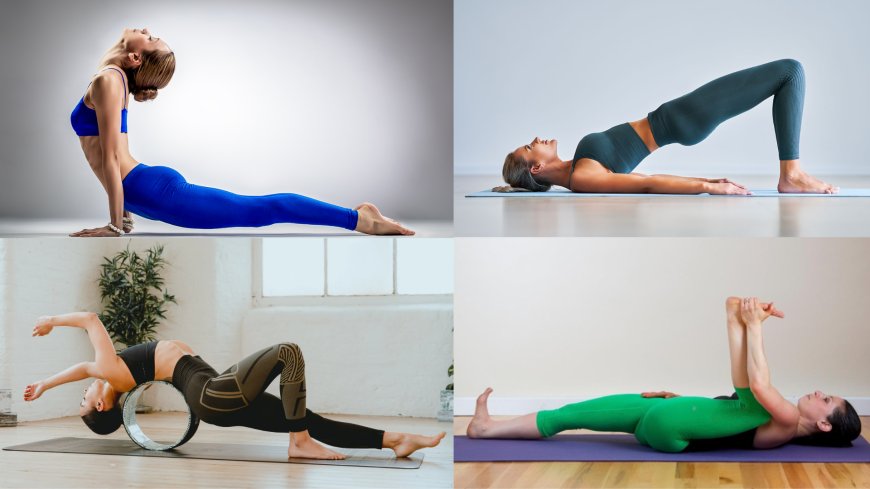The Best Yoga Postures for Backaches and Pain Relief !
Relieve back pain naturally with yoga! Discover the best yoga postures to ease aches, improve flexibility, and strengthen your spine for lasting comfort.

Back pain is a common issue that affects millions of people worldwide. Whether caused by prolonged sitting, muscle strain, or poor posture, back discomfort can significantly impact daily life. Many individuals seek natural and holistic solutions, and yoga has proven to be one of the most effective methods for relieving back pain.
Yoga not only helps alleviate pain but also addresses its root causes. By gently stretching and strengthening the spinal muscles, yoga improves posture, flexibility, and overall spinal health. This article explores the best yoga postures specifically designed to ease backaches and pain, making them suitable for practitioners of all experience levels.
1. Child’s Pose (Balasana)
Child’s Pose is a gentle, restorative pose that stretches the lower back, hips, and thighs. It relieves tension in the spine and promotes relaxation, making it an excellent posture for easing discomfort and preparing the body for deeper stretches.
How to do it:
-
Begin on your hands and knees with your knees apart.
-
Slowly lower your hips back towards your heels, extending your arms forward.
-
Rest your forehead on the mat and breathe deeply.
-
Hold for 30 seconds to 1 minute, focusing on relaxing your lower back.
2. Downward-Facing Dog (Adho Mukha Svanasana)
This foundational yoga pose stretches and strengthens the entire back while improving spinal alignment. It helps lengthen the spine, relieve lower back tension, and enhance posture.
How to do it:
-
Start on your hands and knees.
-
Lift your hips towards the ceiling, forming an inverted “V” shape with your body.
-
Keep your hands shoulder-width apart and feet hip-width apart.
-
Press your palms firmly into the mat and straighten your legs (keeping a slight bend in the knees if necessary).
-
Hold for 5–10 breaths, feeling the stretch along your back and hamstrings.
3. Cobra Pose (Bhujangasana)
Cobra Pose is a gentle backbend that stretches the spine, strengthens the lower back muscles, and opens the chest, encouraging better posture and deeper breathing.
How to do it:
-
Lie on your stomach with your palms under your shoulders.
-
Inhale, press into your hands, and lift your chest off the floor.
-
Keep your elbows slightly bent and shoulders relaxed.
-
Hold for 5–8 breaths, then lower back down.
4. Sphinx Pose (Salamba Bhujangasana)
A milder alternative to Cobra Pose, Sphinx Pose provides a gentle backbend that relieves lower back tension and improves spinal flexibility.
How to do it:
-
Lie on your stomach with your elbows directly under your shoulders.
-
Prop your upper body up on your forearms, keeping your elbows tucked in.
-
Engage your lower back muscles while maintaining a comfortable lift.
-
Hold for 5–8 breaths, then release.
5. Seated Forward Fold (Paschimottanasana)
This pose deeply stretches the back and hamstrings, reducing tightness in the lower back while promoting relaxation and stress relief.
How to do it:
-
Sit on the floor with your legs extended in front of you.
-
Inhale, lengthen your spine, and exhale as you fold forward from your hips.
-
Reach for your feet or use a yoga strap if necessary.
-
Hold for 5–10 breaths, ensuring a long spine.
6. Bridge Pose (Setu Bandhasana)
Bridge Pose strengthens the lower back, glutes, and core while opening the chest and improving spinal alignment. It’s particularly beneficial for those experiencing back pain due to prolonged sitting.
How to do it:
-
Lie on your back with your knees bent and feet flat on the floor, hip-width apart.
-
Press into your feet and lift your hips towards the ceiling.
-
Engage your core and glutes while keeping your neck relaxed.
-
Hold for 5–10 breaths before lowering back down.
7. Pigeon Pose (Eka Pada Rajakapotasana)
Pigeon Pose is a deep hip opener that targets the lower back, glutes, and hips, reducing tension that can contribute to back pain.
How to do it:
-
Start in a tabletop position.
-
Bring one knee forward towards your wrist and extend the opposite leg back.
-
Lower your hips toward the floor and extend your arms forward.
-
Hold for 5–8 breaths on each side, allowing the hips and lower back to relax.
The Benefits of Yoga for Back Pain Relief
1. Improves Spinal Health
Yoga helps maintain spinal flexibility and alignment, preventing stiffness and reducing the risk of back pain.
2. Enhances Posture
Many back problems stem from poor posture. Yoga strengthens core and back muscles, helping to correct posture and prevent slouching.
3. Increases Flexibility and Mobility
Tight muscles in the back, hamstrings, and hips can contribute to back pain. Yoga stretches these areas, increasing mobility and reducing tension.
4. Relieves Stress and Promotes Relaxation
Stress and anxiety can contribute to muscle tension and back pain. Yoga’s mindful breathing techniques and relaxation practices help reduce stress, easing physical discomfort.
5. Strengthens Core Muscles
A strong core supports the spine, reducing strain on the lower back and preventing injuries.
Tips for Practicing Yoga Safely
-
Listen to Your Body: Never force yourself into a pose that causes sharp or intense pain.
-
Use Props: Yoga blocks, straps, and cushions can help make poses more accessible and comfortable.
-
Warm-Up Properly: Begin with gentle movements to prepare your muscles for deeper stretches.
-
Modify When Needed: If a pose feels too intense, use a modification that suits your flexibility level.
-
Practice Consistently: Regular yoga practice is key to experiencing long-term back pain relief.
Final Thoughts
Incorporating these yoga postures into your routine can help alleviate back pain, improve flexibility, and prevent future discomfort. Yoga offers a natural and effective way to manage backaches by addressing their root causes and promoting overall spinal health.
If you experience persistent or severe back pain, consult a healthcare professional before starting any new exercise routine. With consistency and mindfulness, yoga can be a transformative practice for a healthier, pain-free back and improved overall well-being.
What's Your Reaction?
 Like
0
Like
0
 Dislike
0
Dislike
0
 Love
0
Love
0
 Funny
0
Funny
0
 Angry
0
Angry
0
 Sad
0
Sad
0
 Wow
0
Wow
0























